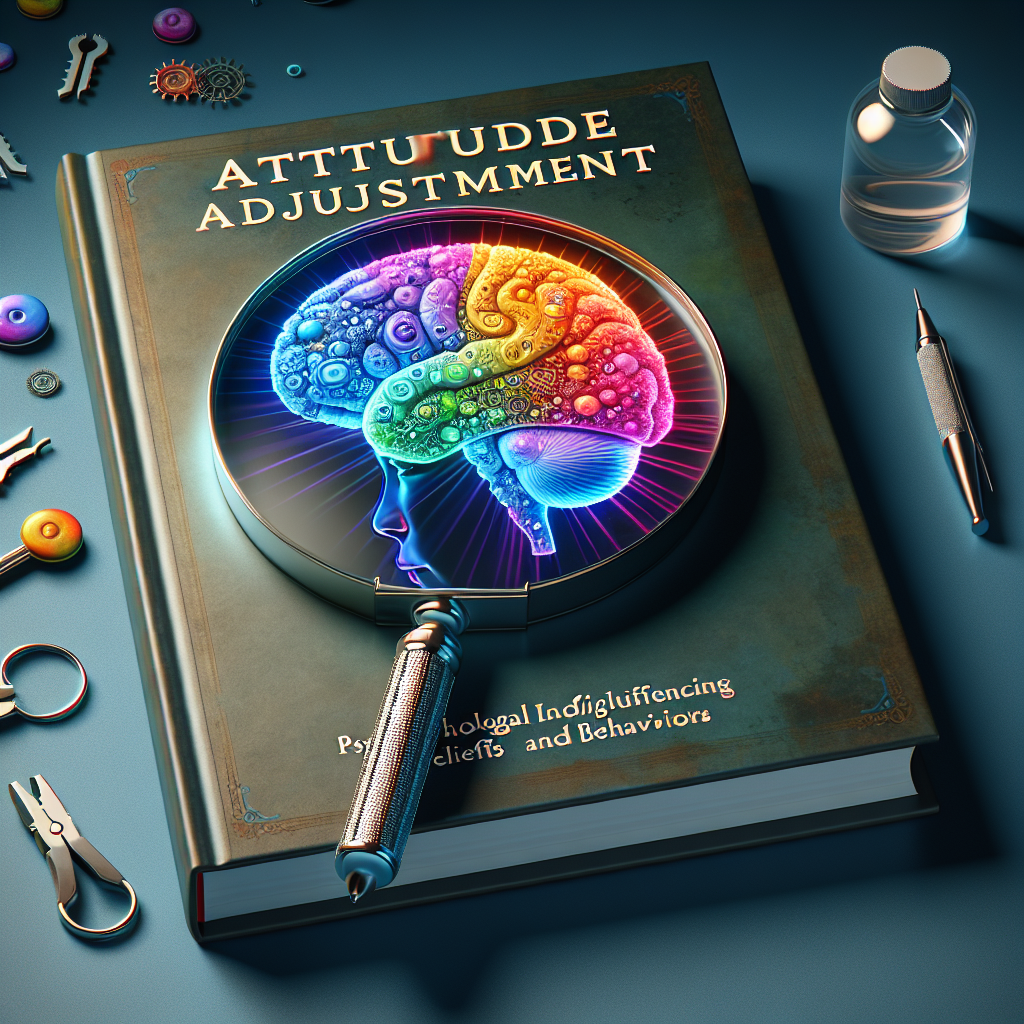
Introduction
Imagine a world where shifting your mindset could reshape your life. Attitude adjustment isn’t just a catchy phrase; it’s a powerful psychological tool that can genuinely alter how we perceive the world and behave within it. In the intricate tapestry of human psychology, the backbone of every decision we make is our attitude—the lens through which we interpret our experiences. Understanding how to influence beliefs and behaviors can lead us to a more fulfilling and proactive life. In this article, we dive deep into the concept of attitude adjustment, exploring psychological insights that provide the keys to transforming not just your perspectives, but also your actions.
The Psychological Foundation of Attitude Adjustment
What is Attitude?
An attitude is a psychological tendency expressed by evaluating a particular entity with favor or disfavour. This can range from preferences to deep-seated beliefs. The psychological theories surrounding attitudes—such as the Theory of Planned Behavior and Cognitive Dissonance—provide the foundation for understanding how to effectively influence attitudes and behaviors.
| Component | Description |
|---|---|
| Cognitive | The beliefs and thoughts about an object or behavior. |
| Affective | The emotional response toward the object or behavior. |
| Behavioral | The intention to act in a certain way toward the object or behavior. |
The Role of Cognitive Dissonance
Cognitive dissonance occurs when a person holds two contradictory beliefs, leading to discomfort. A classic example is when someone who values health smokes cigarettes. To ease the discomfort, this individual may seek to adjust their attitude towards smoking, often downplaying its risks. Understanding cognitive dissonance is crucial for triggering an attitude adjustment, as acknowledging discomfort can pave the way for change.
Strategies for Attitude Adjustment
1. Self-Reflection and Awareness
The first step toward any cognitive shift is self-reflection. Engaging in introspective practices—like journaling or meditation—can help individuals recognize harmful beliefs.
Case Study: The Power of Journaling
A study by the University of California found that individuals who engaged in expressive writing experienced significant improvements in both mental health and an overall positive outlook. Those who journaled about their negative experiences reported better attitudes towards life, demonstrating the transformative potential of self-reflection.
Analysis: Self-reflection enables individuals to confront their preconceived notions, effectively laying the groundwork for a positive attitude adjustment.
2. Positive Reinforcement
Rewarding positive behaviors reinforces new attitudes. This can be in any form, from verbal praise to tangible rewards.
Case Study: The Sesame Street Effect
Research involving Sesame Street found that children who received commendation for participating in educational activities were more likely to engage positively in the future. By celebrating successes—no matter the size—individuals are encouraged to adopt more favorable attitudes.
Analysis: Emphasizing and rewarding positive behavior cultivates a loop of encouragement, promoting ongoing attitude adjustments.
3. Exposure to New Perspectives
Being open to new experiences can alter attitudes. This can include engaging with diverse social groups or consuming different media.
Case Study: The Contact Hypothesis
The Contact Hypothesis suggests that bringing people of different backgrounds together reduces prejudice and improves intergroup attitudes. A classic psych experiment showed that desegregated schools significantly improved attitudes toward peers of different races among students.
Analysis: Exposure to new ideas and cultures broadens one’s perspective, often resulting in more inclusive and understanding attitudes.
4. Cognitive Restructuring
Cognitive restructuring involves changing the way you think about a situation. This technique can often be seen in cognitive-behavioral therapy.
Case Study: Cognitive Behavioral Therapy (CBT)
Clinical studies have shown that CBT can significantly alter negative thought patterns, resulting in more positive attitudes and improved behaviors. Patients suffering from anxiety were noted to have changes in both their attitudes and subsequent behaviors following CBT.
Analysis: The ability to reframe negative thoughts leads not only to personal empowerment but also to a sustainable shift in attitude.
5. Social Influences and Role Models
Surrounding oneself with positive role models can significantly enhance attitude adjustment.
Case Study: Role Models in Youth Development
A study from the University of Michigan found that children who modeled behaviors after positive adult role models exhibited significantly improved academic and social attitudes.
Analysis: Positive role models serve as a tangible representation of the attitudes we aspire to adopt, making them powerful catalysts for change.
The Importance of Communication in Attitude Adjustment
Verbal and Nonverbal Cues
Effective communication is paramount when influencing others’ attitudes. Both verbal affirmations and nonverbal cues—like body language and facial expressions—play crucial roles in conveying messages.
Effective Messaging Strategies
- Using "I" Statements: Helps in expressing personal beliefs without sounding accusatory.
- Active Listening: Encouraging open dialogues increases the likelihood of altering someone’s attitude.
Case Study: Communication in Conflict Resolution
Research has demonstrated that individuals engaged in active listening during conflict resolution processes exhibited more favorable attitudes towards compromise and collaboration.
Analysis: Effective communication can shift the attitudes of both parties involved, promoting mutual understanding.
Measuring Attitude Adjustments
Surveys and Feedback Loops
To understand if attitude adjustments have been successful, utilizing surveys can evaluate shifts in beliefs and behaviors.
Tools for Measurement
- Likert Scales: To gauge perception improvements before and after interventions.
- Behavioral Observations: Tracking changes in behavior as a testament to shifts in attitude.
Case Study: A Workplace Intervention
A company implementing regular employee feedback via surveys found that addressing concerns led to a significant increase in job satisfaction and employee morale, demonstrating changes in collective attitudes.
Analysis: Measuring attitudes through structured feedback mechanisms ensures that the process aligns with the desired objectives.
How to Sustain Attitude Adjustments
Creating a Supportive Environment
Organizational culture plays a substantial role in sustaining attitude adjustments. A supportive environment encourages individuals to maintain positive shifts.
Case Study: Google’s Workspace
Google’s focus on a collaborative workspace has been linked to heightened employee satisfaction and improved attitudes towards work, inspiring innovative solutions and collaborative effort.
Analysis: Creating a supportive space fosters ongoing engagement and positive attitudes among team members.
Ongoing Development and Learning
Continuous learning and development can help maintain attitude shifts over time.
Importance of Lifelong Learning
Providing access to training and development opportunities enhances individual self-efficacy, a known precursor to sustained attitude adjustments.
Analysis: Knowledge and growth contribute to confident attitude shifts that last, enabling individuals to adapt and thrive.
Conclusion
Attitude adjustment is not merely a conceptual idea—it’s an empirical reality. By leveraging psychological insights, such as cognitive dissonance and social influence, you can effectively influence beliefs and behaviors. Whether through self-reflection, positive reinforcement, or sustained learning, transforming attitudes can lead to profound changes in both personal and collective experiences.
The journey to attitude adjustment may not be straightforward, but it is undeniably rewarding. With these strategies in hand, the power to change begins with you.
FAQs
1. What is the first step in changing my attitude?
Start with self-reflection. Acknowledge your current mindset and identify areas you wish to change.
2. Can attitudes really change over time?
Yes, attitudes can change through various methods, including exposure to new ideas, positive reinforcement, and cognitive restructuring.
3. How does cognitive dissonance affect my beliefs?
When you experience cognitive dissonance, it can prompt you to change either your beliefs or behaviors to resolve the discomfort.
4. What role do role models play in attitude adjustment?
Role models can inspire and provide a tangible example of the attitudes and behaviors you aspire to adopt.
5. How can I measure if my attitude has changed?
Using surveys, feedback, and behavioral observations can effectively measure shifts in beliefs and behaviors over time.
Whether you’re seeking personal growth or looking to influence others positively, embracing the principles of attitude adjustment will set you on a path toward a more fulfilling and impactful life.

















